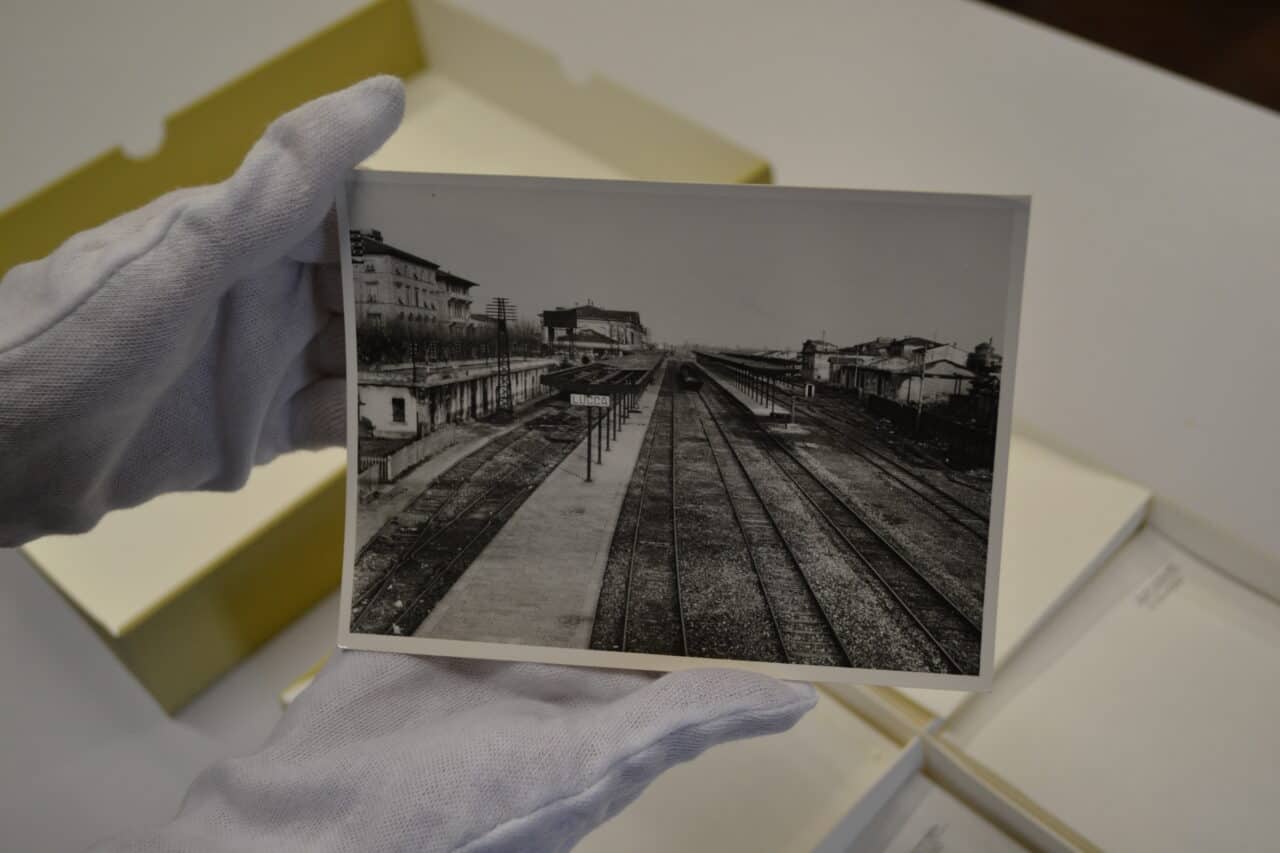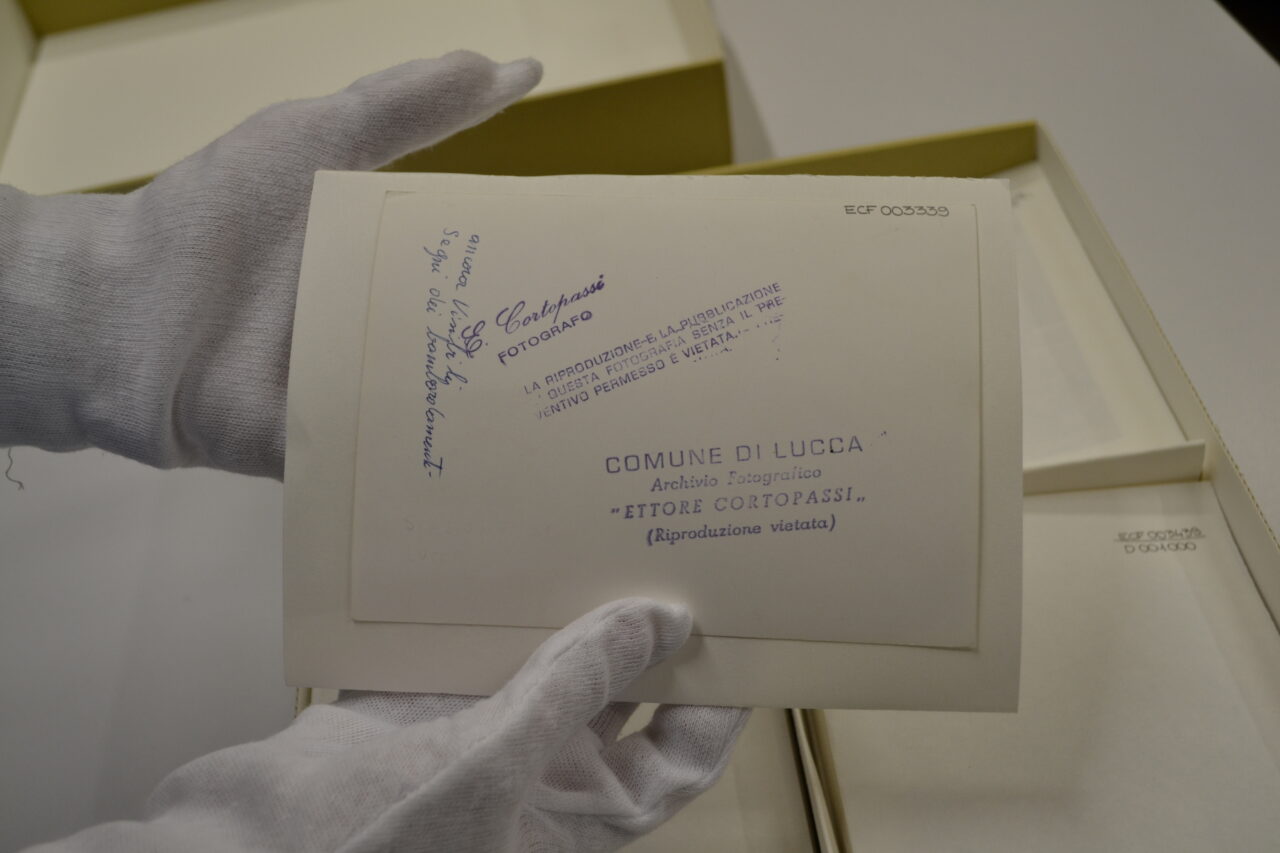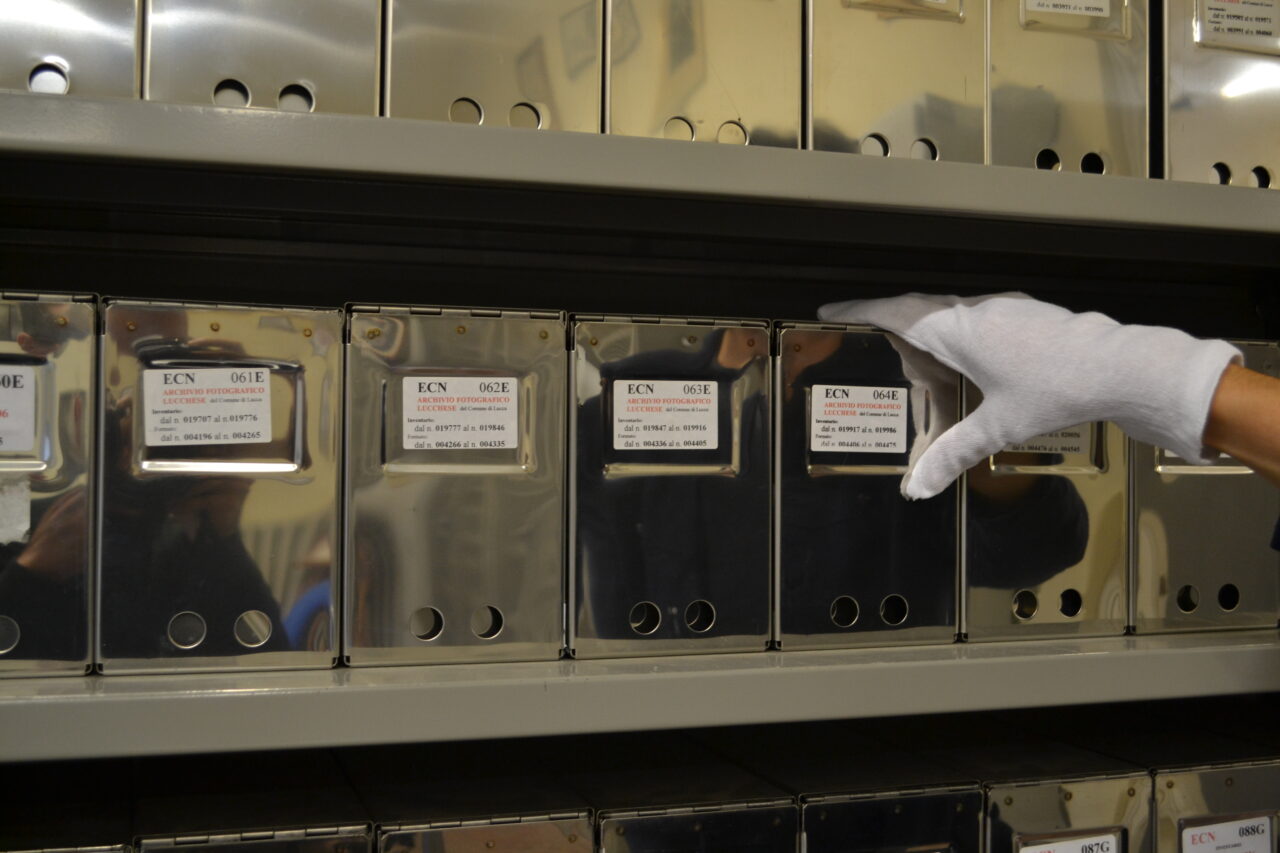
In your hands – or more precisely between your gloves – is a print that represents the Lucca station, observed from a raised point of view that leads your gaze to follow the lines of the tracks until it gets lost on the horizon. Turning it around, we notice how the back of the photograph is inhabited by numerous annotations: the first, at the top left and in blue pen, reads "still visible signs of the bombing". We are facing a precious testimony of the contemporary history of the city of Lucca. The note guides us in reading the image, relocating the photographic object in its original spatial and temporal context – a day in January 1944 – and at the same time providing important visual information for the social and cultural memory of Lucca. Looking again we find the stamp “E. Cortopassi”, attributable to the author of the photograph: Ettore Cortopassi from Lucca, (1895-1989), one of the greatest exponents of Tuscan photography, who for over half a century documented the city's society and historical-artistic heritage. Furthermore, a second stamp, placed a little further down, refers to this author, which reads “Comune di Lucca – “Ettore Cortopassi” photographic archive: a further element to reconstruct the biography of this photographic object.
We know, in fact, that starting in 1979 Cortopassi's photographic production was acquired by the City of Lucca, gradually giving shape to what was originally called the 'Ettore Cortopassi' Photographic Archive. During the 1980s, the work of organising this archive, which has been housed in Villa Bottini since 1988, was carried out in particular thanks to the scholar Arnaldo Fazzi, who was engaged in a systematic recovery of Lucca's photographic heritage. After a series of acquisition campaigns and thanks to several donations, the archive, now called Archivio Fotografico Lucchese "A. Fazzi", reached more than one million photographic objects organised in 22 funds, as well as photographic equipment, books and magazines.

In order to valorise and better preserve the photographic heritage as a source of memory and as a civic and public heritage, the project "Archivi in Rete" (Archives on the Net) was created by the Scuola IMT Alti Studi Lucca in collaboration with the Municipality of Lucca and, in particular, with the Archivio Fotografico Lucchese "A. Fazzi". Conducted by the authors of this article, Agnese Ghezzi and Fabrizio Gitto, researchers specialised in the history of photography, and scientifically directed by Linda Bertelli, professor of aesthetics and visual studies at the Scuola IMT Alti Studi Lucca, the project aims to map and study the richness and heterogeneity of the various institutions in Lucca that preserve photographs.
As the analysis of the print of the ancient station of Lucca has shown, every photograph is not only constituted by the image represented but also by its materiality, its context of production, its various institutional passages, its physical movements and the multiple functions that the object has acquired over time. Photography can therefore only be understood in relation to its archive, the physical place where it is stored, to be understood as the guardian of the past in constant dialogue with the society that produced it. As has been pointed out by French historian Jacques Le Goff, every document can be considered a monument because "the document is not an unsold commodity of the past, it is a product of the society that manufactured it". This assertion underlines the physical and material value of the content of archives, to be considered as a fragment of the past that has not simply been deposited but has been preserved as a result of choices and selections, a fragment that requires the reconstruction of its context of origin, dissemination and preservation in order to be understood and reactivated.
This perspective on the processes of documental heritage construction has generated a wide and constant attention on archives in recent decades, leading to their inclusion within disciplinary paths within which they had never been studied, such as artistic, museum, curatorial, educational, philosophical, legal, etc. The archive, therefore, is no longer understood as a static and immobile space where materials to which only researchers can have access are piled up, but it is also recognized as having an important social function: it is a fundamental place for reflecting on the community, the collectivity and possible memories.

Consequently, each archive is an autonomous ecosystem that weaves dense relationships with its producer, its location and other archives in a dynamic process that changes and evolves over time. Documents, consequently, leave (even if only metaphorically) the four walls in which they are physically stored to dialogue with other objects, giving shape to a vast and interconnected heritage, like islands in an archipelago connected by bridges. It is precisely the focus on the connections between archives rather than on the value of individual documents that allows for a new and broader reading, one that highlights not only the mere sum of the materials but also the variety of relationships between objects and preservation institutions.
With this in mind, the project, which will continue until 2024, will lead to the creation of a network between the city's institutions, with the description of the various photographic funds in a single database that will allow to conduct interconnected research on the heritage and to generate new paths for the rediscovery of archives, local memory and photographic culture. So far, more than thirty Lucca institutions of various kinds have joined the 'Archivi in Rete' project, among which the Archivio di Stato, the Lucca Documentation Centre, the Historical Archive of the Catholic Movement of Lucca and the Licia and Carlo Ludovico Ragghianti Art Study Centre Foundation.
"Archivi in Rete" is aimed not only at specialists but also at enthusiasts: the online portal will publish a census of the photographic heritage preserved by the various member institutions; there are also plans for paths aimed at citizenship for the recovery of local memories through photography and workshops in schools for education and training on photography.
###
"Archivi in Rete" is a project led by Agnese Ghezzi and Fabrizio Gitto, research collaborators specialised in the history of photography, and scientifically directed by Linda Bertelli, professor of aesthetics and visual studies. Lead partner of the 'Archives on the Net' project is the research unit LYNX - Center for the Interdisciplinary Analysis of Images, Contexts, Cultural Heritage of the IMT School through a group of experts from different disciplines (Maria Luisa Catoni, Giorgio Stefano Gnecco, Riccardo Olivito, Andrea Averardi, Francesca Leonardi, Emanuele Carlenzi), in collaboration with the Municipality of Lucca and in particular the Archivio Fotografico Lucchese 'A. Fazzi' . "Archivi in Rete" is promoted by the Fund for Development and Cohesion of the Region of Tuscany, through a call for advanced training within the GiovaniSì activities and with the contribution of Fondazione Cassa di Risparmio di Lucca, the Hyperborea company and the Photolux association.